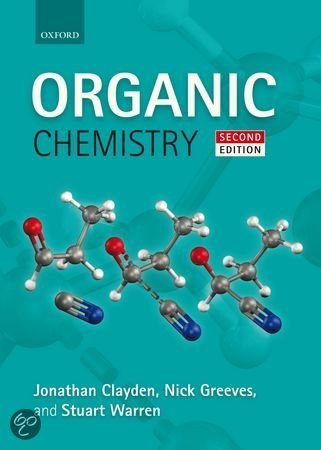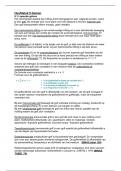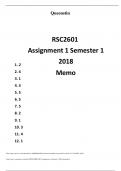Representation, Isomerism and Bonding
25 September 2017 15:25
Interesting facts:
DRAWING AND NAMING ORGANIC MOLECULES • Organic molecules left to decompose for millions of years in the
absence of light and oxygen become literally carbon skeletons -
• The term "organic" is used to describe the chemistry of compounds of carbon with other crude oil is a mixture of molecules consisting of nothing but
elements. In the 19th century, chemists believed that compounds from living organisms were carbon and hydrogen, while coal consists of little else but carbon.
too complex for it to be possible that they could be synthesised from non-living things. The • Coal and oil both don't have functional groups, so the only
"organic" label was therefore associated with compounds bearing a "vital force" which chemical reaction they can take part in is combustion.
conferred the characteristics of living beings onto this form of matter. • Three fatty acid molecules and one glycerol molecule combine to
• Wohler managed to manufacture urea in the 19th century, which was a major breakthrough form the fats that store energy in our bodies and are used to
as a compound from a living organism (constituent of urine) was prepared from inorganic salt construct the membranes around our cells.
ammonium cynate, therefore disproving the belief mentioned in the previous bullet point.
Drawing molecules accurately
• Common organic molecules that you encounter in everyday life: • Drawing molecules with skeletal formula (as shown on the left) allows to
accurately and quickly draw complex 3D structures in a 2D format so that we
can quickly recognise points of interest in the molecules, such as functional
groups and stereochemistry e.g.
• A single line represents one bond (consists of two electrons shared between
two atoms at either end of the bond).
• A double line represents two bonds (double bond = 4 electrons)
• Each kink in the line is a carbon atom, unless otherwise specified.
• Carbon always has 4 bonds, unless it is a carbocation or a carbene
• A carbon with n bonds drawn (n= an integer between 1 and 4) has 4-n bonds
to hydrogen
• We often draw benzene rings as a mixture of single and double bonds (as per Kekule,
• Bonds drawn as solid wedges are coming out of the paper relative to simple
rather than commonly used circle) for mechanistic purposes, as by drawing it this way
lines, and bonds drawn as dashes are going in to the paper.
we implicitly recognise the aromaticity and delocalisation.
• Resonance forms recognise that the pi-electrons are delocalised: The Shape of Hydrocarbons
• If you look at the 3D shape of methane, we can see that the carbon is at the centre of a
regular tetrahedron, with two hydrogen atoms positioned on the corners of each face. If a
• When drawing tetrahedral carbon, two bonds are in the plane of hydrogen atom is exchanged for a carbon or another atom, the shape at central C does not
the paper, one bond is coming out of the paper (wedge) and one change. This is tetrahedral carbon.
bond is going into the paper (dash). • The carbon is sp3 hybridised (a carbon bonded to 4
separate atoms is always sp3 and tetrahedral). Adoption
of tetrahedral geometry can be explained using Valence
Shell Electron Pair Repulsion (VSEPR) theory.
• The tetrahedral geometry is one in which all four bonds (pairs of electrons) are equally as far
away as possible (bond angle 109.5o), as the electrons in the valence shell around carbon (i.e.
• These are incorrect ways to draw tetrahedral carbon as they the electrons in the C-H bonds) repel electrons in all the other bonds.
either do not show the correct geometry around carbon or are
ambiguous with respect to the precise 3D shape of the molecule. • It can be fine to draw 3 or 4 bonds from carbon all in the
plane of the paper if we are not discussing stereochemistry
e.g. can draw this molecule (has a chiral carbon), but if we are
talking about a specific enantiomer must draw 3D structure.
Drawing Molecules Functional Groups
• When drawing molecules we must use as simple structures as possible, convey • Functional groups determine the way a molecule works both chemically and
all necessary information and cut out all superfluous information. biologically, and the chemistry of an organic molecule depends more on other
When dealing with long chains e.g. linoleic acid (C5H13CH=CHCH2CH=CHC7H14COOH): types of atoms in the molecule (O, N, S, P, Si…) than on the number or
1. Draw the chains of atoms as zig-zags (represents the tetrahedral nature of arrangement of carbon or hydrogen atoms.
carbon compounds, however in this example there are carbon of double bods • Functional groups are found where we have types of atoms other than C or H
which are flat (trigonal planar) and sp2 hybridised). X-ray crystallography (O, N, S, P, Si - heteroatoms (any atom in an organic molecule other than C or
discovers the structures of molecules by observing the way x-rays bounce off H)) or double or triple bonds.
atoms in crystalline solids. • Molecules are often classed by the type or combinations of functional groups
2. Miss out the hydrogen atoms attached to carbon atoms and the C-H bonds, they contain e.g. amino acids have very varied structures but all contain the
unless there is good reason not to e.g. if it is involved in a reaction. same two functional groups: amino and carboxylic acid).
3. Miss out the capital C's representing carbon atoms, unless there is good
reason not to. Type of functional group Notes
Oxidation levels at carbon Alkanes: C-C, they have no functional groups Often denoted generically as R, the alkyl group, R-
Carbon atoms containing functional groups can be classified at oxidation and are very unreactive. They are often used as H is an alkane
level. The structure, bonding and reactivity of the functional groups with solvents.
the same oxidation level are similar to some extent.
• The carbon dioxide oxidation level: carbon has 4 bonds to a Alkenes: C=C double bond C=C bond gives reactivity. Coloured organic
heteroatom e.g. oxygen, nitrogen or halogen. compounds often contain rings or chains of C=C.
Alkynes: C≡C triple bond
Alcohols: R-OH OH is the hydroxyl group, soluble in water due to
hydrogen bonding.
• The carboxylic acid oxidation level: carbon has 3 bonds to a
heteroatom and only one to a C or H. Ethers: R1-O-R2 e.g. EtOEt diethyl ether OR is the alkoxy group, e.g. OEt is ethoxy. The name
ether refers to any compound that has two alkyl
groups linked through an oxygen atom.
Amines: R-NH2 NH2 is the amino group, often have powerful fishy
• The aldehyde oxidation level: carbon has 2 bonds to a heteroatom smells
Nitro compounds: R-NO2 NO2 is the nitro group, where nitrogen has one
double bond to oxygen, a single bond to oxygen
and single bond to R. Several nitro groups in a
• The alcohol oxidation level: carbon has 1 bond to a heteroatom.
molecule can make it quite unstable and even
explosive
Alkyl halides: R-X, where X represents a halide R-X (X=Cl, Br, I, F) is sometimes used. Aryl halides
Organic Chemistry I Page 1












